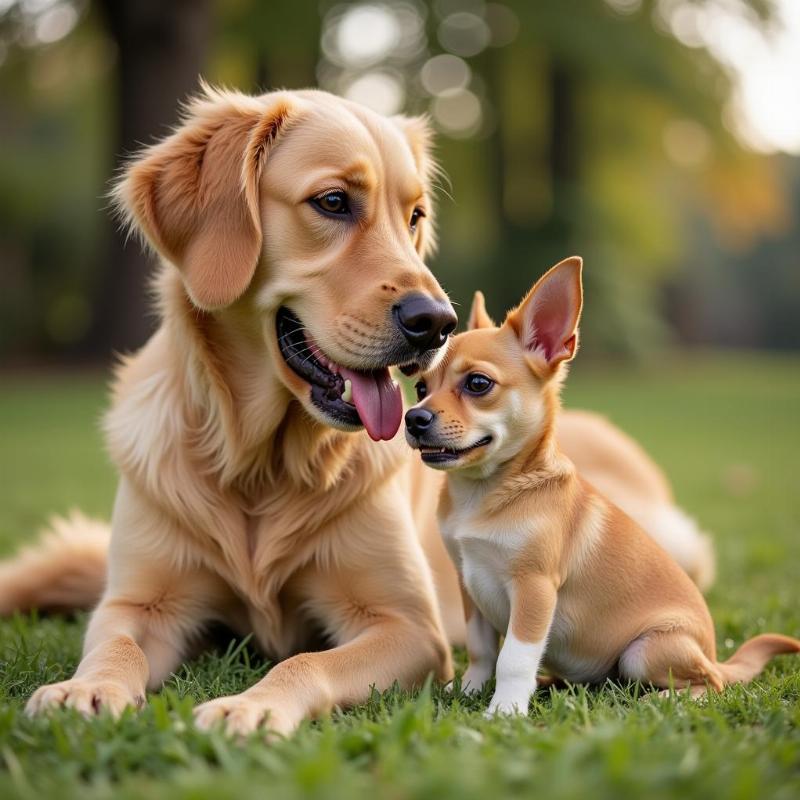Introducing a big dog breed into a home with a small dog can be a rewarding experience, but it requires careful planning and consideration. While the image of a Great Dane cuddling a Chihuahua might seem adorable, size differences can create challenges if not managed properly. This article explores the key factors to consider when combining big and small dogs in one household, focusing on safety, training, and creating a harmonious environment for both.
Understanding the Dynamics: Size Matters
 Big Dog and Small Dog Interaction
Big Dog and Small Dog Interaction
The most obvious difference between big and small dogs is their physical size, which directly impacts their interactions. A playful nudge from a large breed could easily injure a smaller dog, even unintentionally. Understanding this potential for accidental harm is crucial. Big dogs, even the gentlest giants, can be unaware of their strength and size, especially during playful moments. This isn’t to say that large and small dogs can’t cohabitate peacefully; it just means you need to be prepared to manage their interactions effectively.
Temperament and Personality: More Than Just Size
While size is a primary concern, temperament and personality are equally important factors. A small, feisty dog might be more likely to provoke a larger, more laid-back dog. Conversely, a large, overly energetic dog could overwhelm a smaller, shy dog. Before introducing any dogs, regardless of size, assessing their individual personalities is vital. Consider their play styles, energy levels, and reactions to new situations.
Introduction and Socialization: Slow and Steady Wins the Race
Introducing a big dog to a small dog should be a gradual process. Initial introductions should be supervised and in a neutral, controlled environment. Use baby gates or separate areas to allow them to see and smell each other without direct contact. Short, supervised play sessions can then be introduced, gradually increasing the time spent together as they become comfortable. Positive reinforcement, such as treats and praise, encourages positive interactions and helps build a positive association between the dogs.
Creating a Safe and Harmonious Home
Providing separate spaces for each dog is essential, regardless of how well they get along. This gives each dog a safe haven where they can retreat when they need some alone time. Separate feeding areas also prevent resource guarding, a common issue that can escalate quickly between dogs of different sizes. Ensure both dogs have access to appropriate toys and enrichment activities to prevent boredom and minimize the potential for conflict.
Training and Management: Essential for Success
Consistent training is crucial for a multi-dog household, especially one with significant size differences. Both dogs should be well-trained in basic obedience commands, such as “sit,” “stay,” and “come.” This allows you to manage their interactions effectively and intervene when necessary. Teaching a “leave it” command is also invaluable, as it can prevent the larger dog from accidentally injuring the smaller dog during play or when vying for a toy.
Conclusion: A Big Dog and a Small Dog Can Live Together
Living with a big dog and a small dog can be a wonderful experience. With careful planning, proper introductions, consistent training, and ongoing management, you can create a safe and loving environment where both dogs thrive. Remember that every dog is an individual, and understanding their unique needs and personalities is the key to a successful multi-dog household.
FAQ:
- Can a Great Dane live with a Chihuahua? Yes, but careful supervision and management are essential due to the significant size difference.
- What if my big dog is too rough with my small dog? Consult with a professional dog trainer for guidance on managing their interactions.
- How can I prevent resource guarding between my dogs? Feed them in separate areas and provide each dog with their own toys and chews.
- Is it okay if my dogs don’t become best friends? As long as they coexist peacefully and respectfully, it’s perfectly fine if they don’t become inseparable.
- Should I get another small dog if I already have a big dog? Consider your big dog’s temperament and personality, as well as your ability to manage multiple dogs, before making a decision.
- What are some signs of stress in a small dog living with a big dog? Excessive panting, hiding, tucked tail, and loss of appetite can indicate stress.
- How can I make sure both dogs get enough attention? Schedule individual playtime and training sessions with each dog to ensure they receive dedicated attention.
Beautdogs.us is your premier source for comprehensive dog care information, breed expertise, and product recommendations. Whether you’re a seasoned dog owner or just starting your journey, Beautdogs.us is your trusted companion for all things dog-related. We offer expert advice on everything from dog nutrition and training to finding the perfect products for your furry friend. Contact us at [email protected] or +1 501-555-7529. Let Beautdogs.us help you create the perfect life for you and your canine companion!